County Donegal History And Heritage
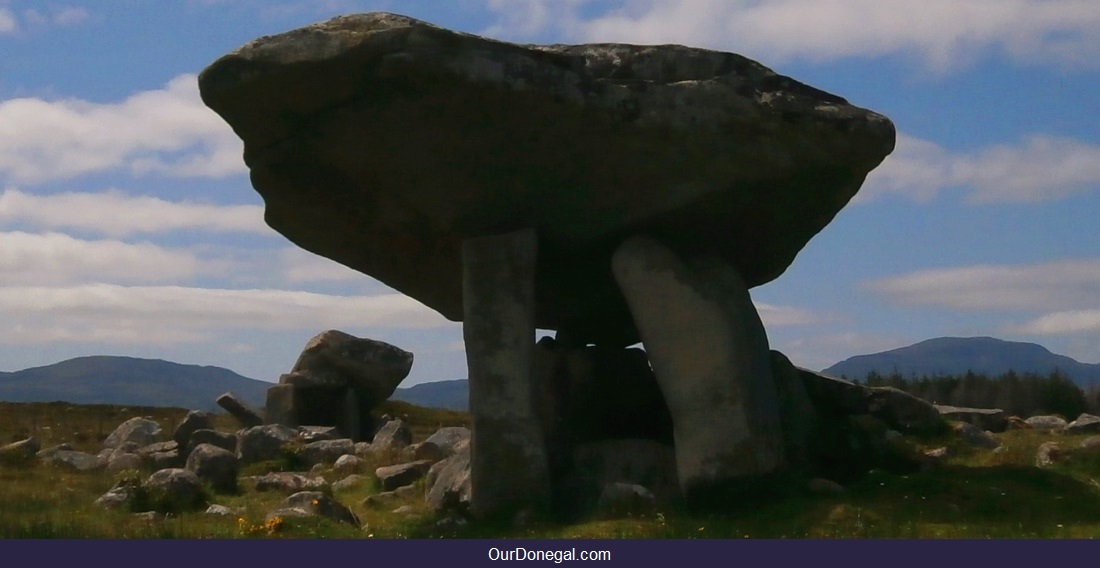 Neolithic portal tomb (dolmen) at Kilclooney, near Ardara in County Donegal
Neolithic portal tomb (dolmen) at Kilclooney, near Ardara in County DonegalCeltic History, Ancient, Mysterious structures of County Donegal
County Donegal is abundant in a variety of pre history megalithic stones, ancient monuments and buildings spanning periods up to and beyond the Early Christian era.
All together they form a cherished
Celtic legacy and a window to the past that you can enjoy exploring at
your leisure.
Mesolithic Age, Neolithic Era, Early Christian Heritage
Some of the oldest examples of megalithic stones include wedge tombs, dolmens (or portal tombs) and court cairn burial chambers of the Neolithic Era. In addition, many small flint tools, known as microliths dating from the Mesolithic Age have been found at various locations around the county. Fine examples of stone circles, ring forts, standing stones and early Christian craftsmanship have also survived.
In fact, archaeologists believe that Donegal was inhabited by humans not long
after the great glacial thaw that ended the Ice Age. That event,
thought to have occurred in the county by approximately 8,000BC, marked
the start of the Mesolithic Age. That is, the Middle Stone Age, the period before the Neolithic Era.
Microliths And Megalithic Stones Of County Donegal
8,000 - 10,000 Year Old Microliths
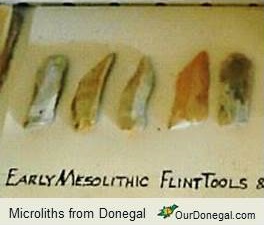
Numerous flint tools, known as microliths, dating to the Early Mesolithic Age have been found in various locations around County Donegal. Those pictured were found in Greencastle in Inishowen. You can view them in the Donegal Historical Society's museum room at the Franciscan Friary, Rossnowlagh.
5,600 Year Old Court Tomb
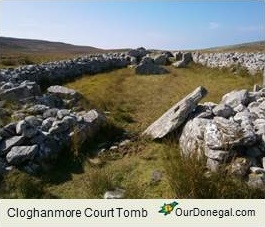
You'll find this 47 meter long Neolithic Era court tomb near Malin More and Glencolmcille, Southwest Donegal. It is a very rare example, having a double court. A total of four burial chambers lead off the court area, two flanking the short entrance passage in the foreground, and another two at the back, both of those divided into two.
What's the Difference Between...
Portal Tombs
Portal tombs have a table-like appearance. They consist of a single large flattish rock slab that sits horizontally, or slightly tilted on top of several upright supporting rock slabs. The overall effect is the formation of a roof over a chamber. Neolithic era.
Dolmens
Dolmens are another name for portal tombs.
Wedge Tombs
Wedge tombs are from the late Neolithic era to mid Bronze Age. They get their name from the distinctive wedge-like formations of their burial chambers which decrease in both height and width lengthwise. Wedge tombs are apparently unique to Ireland.
Cromlechs
The term 'cromlech' is sometimes used instead of 'dolmen'. However, it can also mean 'stone circle'.
Court Tombs
Court tombs are unique in that a spacious gallery area is incorporated into the overall design of these exceptionally long structures. The gallery can be found at the end of a short entrance passage to the tomb. From the Neolithic era.
Court cairns
Court cairns are another name for court tombs.
All of the above structures are thought to have been originally covered over
by a large mound of rocks called a cairn, possibly topped with a layer of earth
Trace The Footsteps of County Donegal's Earliest Tribes
So who were those enigmatic people who came to Donegal so long ago? And where did they come from?
Archaeological findings, great as they are, only reveal so much, and the accuracy of standard testing methods seem to be under question for apparently relying on unproven assumptions. Therefore the above questions might never be fully answered. However, some of the gaps can be filled with the help of ancient handwritten manuscripts and modern scientific breakthroughs.
The ancient manuscript records are particularly interesting. They're derived from the inherited oral testimonies of generations of specialist historians from pre-writing times.
According to those records, Ireland was inhabited by seven successive tribes at varying times in the prehistoric past. Incredibly, the origins of all seven ancient tribes appear to trace all the way back to Noah of the great Biblical flood, through the ancestral lineage of his sons.
Cessair
The first of those tribes, Cessair and her people, arrived before
the Biblical flood. We found no record of Cessair, a granddaughter of
Noah, having ever reached Donegal. What was left of their small group apparently perished in the deluge.
The other six tribes however,
all of them arriving after the great flood, had strong links to County Donegal.
Pre History Fomorian Pirates of the Atlantic
The fearsome Fomoire, or the Fomorian tribe, pirates of the Atlantic region, were the first of the post-flood arrivals.
Their ancestral lineage was of Noah's son Cham and they were believed to have arrived via either the Mediterranean area or Scandinavia.
They established a base on Tory Island, off County Donegal's Northwest coast, from where they wreaked havoc on later settlers on the mainland.
The Arrival of the Five Celtic Tribes of Ireland and Donegal
Over time the Fomorians were followed by a total of five more groups.
Those were the ancient Celtic tribes of Ireland, descendents of Noah through the lineage of his son Japheth.
All five tribes had strong ties with Scythia, a large region in Central Eurasia encompassing parts of present-day Ukraine, Russia and Central Asia.
They all spoke a common language, the original
Celtic language of Gaoidhilg, now called Gaelic and still spoken in parts of Donegal and elsewhere.
They
were, in order of arrival . . .
1. Muintir Partholóin
2. Muintir Nemid
3. Na Fir Bolg
4. Tuatha de Danann
5. Clan na Míle
1. Muintir Partholóin, the Tribe of Partholon
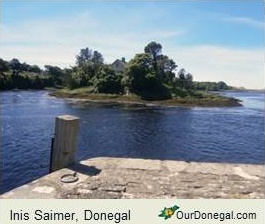
The Partholonians were the first of the Celtic tribes to arrive in Ireland. Their leader, Partholon and his wife Dealgnait settled on a tiny sheltered island on the estuary of the river Erne at Ballyshannon near the southernmost tip of County Donegal. They named their new home Inis Saimer.
Saimer, or Samer is an ancient Gaelic name for the river Erne. It means 'River of the Morning Star'. From inis Saimer, the river Erne flows from the East, and must have looked particularly beautiful to the Partholonians in the light of the early morning sun.
This pretty island still exists today. You can see it just a 'stone's throw' from the pier at Ballyshannon.
2. Muintir Nemid, the Tribe of Nemid
Following the death of their leader, Nemed, these people were cruelly oppressed by the Fomoire for years.
The Nemidians eventually rose up against their oppressors at Tory island off County Donegal's coast, however they sustained heavy losses and were forced to flee Ireland.
Some of Muintir Nemid traveled as far as Greece where they became enslaved.
3. Na Fir Bolg, the Firbolg Tribe
The
Firbolg were descendents of those Nemidians who had settled and become
enslaved in Greece. Tired of enslavement, the Firbolg eventually fled
Greece, making their way to Ireland.
Ireland Becomes a Monarchy
The Firbolg established a formal system of Irish monarchy under a succession of Celtic Kings.
Under this system, not only did they have a supreme Monarch, Sláine Mac Dela being the first, they also had regional kings who, along with their subjects, were governed entirely by Ard Rí na hÉireann, as the supreme High Kings of Ireland were titled.
The Firbolg were the first to introduce a formal system of monarchy in Ireland, ruling with a succession of one hundred and fifty High Kings from the Royal Hill of Tara.
It was a system that would prevail for the next four thousand years being adopted, with some modifications by Tuatha de Danann and later the Milesians.
Overpowered by Tuatha de Danann, who in turn were overpowered by the Milesians, the Firbolg turned to farming and shepherding.
4. Tuatha de Danann
This tribe is Believed by some to be the biblical 'Lost Tribe of Dan', or Danite. They overpowered the Firbolg.
Gifted, masterful craftsmen, they built a magnificent royal palace at Áileach in North Donegal. Áileach was one of three of the strongholds of the Tuatha de Danann, the other two being in Tara and Connaught.
These intelligent peoples devised their own ancient alphabet unique to Ireland. They called it Ogham. Every letter was associated with a native Irish species of tree or bush. Rare examples of ancient Ogham writing, believed to be over 3,200 years old can still be found, though we're not aware of any in County Donegal.
The palace of Áileach long gone, a circular stone fort was later built on the hilltop site, and remains in existence today. Áileach later became a stronghold of the powerful O'Neill clan, descendents of Heremon, the first Milesian High King of Ireland.
5. Clan na Míle, the Milesians, or Gaelic Race
The Milesians were the Gaels, the original Gaelic race, formidable Celtic warriors. They were the last of the great Celtic tribes to conquer Ireland. Their King Milesius, or Míl Espáine in Gaelic, himself an acclaimed warrior got his name having won a thousand battles. 'Míle' is the gaelic word for 'thousand'.
The
Milesians had already colonized Portugal and much of Spain, including
Galicia before conquering Ireland and from there, Scotland.
Milesians Meet Tuatha de Danann in Donegal, Milesian Conquest of Ireland
Prior to their invasion of Ireland, the Milesians sent an expedition party headed by Íth, who was King Míl's uncle. They made contact with the three jointly ruling High Kings of the Tuatha de Danann during that expedition and were cordially received in County Donegal, at the royal palace of Áileach. However while returning to their ship, Íth was brutally slain.
The Milesians then amassed an army and invaded Ireland, subduing Tuatha de Danann. Ancient texts record that event to have occurred over 3,700 years ago c.1699BC. King Míl, however never got to Ireland, having died shortly before the invasion took place. His eight sons carried the task to fruition in his memory, five of them perishing at sea during a ferocious storm in the process.
Two of
Míl's surviving sons Heber and Heremon, along with his deceased son Ir
became ancestors to all the Milesian Gaels of Ireland and Scotland, Ir
having left an only son, Heber Donn.
High King Heremon, Successive Gaelic High Kings of Celtic Ireland
Heremon was the first Milesian, or Gaelic Celtic High King of Ireland. He ruled jointly with his brother Heber for the first year before slaying him in a duel. He was the first of a line of a hundred and eighty two successive Gaelic High Kings of Ireland, one Gaelic High Queen, and one Firbolgian High King. Between them, they reigned supreme over all of Ireland for almost 3,000 years before relinquishing their power to the English Crown King Henry II.
All but six of the great Gaelic monarchs were of the direct line of King Míl through his sons Heber, Heremon and the deceased Ir through his surviving son Heber Donn. They were of the Milesian line of the Gaelic High Kings of Ireland.
Thirty
eight of those High Kings came from the line of Heber and twenty six
were of the line of Ir. A hundred and fourteen High Kings of Ireland
were descended from Heremon, as were many royal, noble and elite
families of various parts of Ireland including Tír Chonaill, another
name for County Donegal. Scottish and English monarchs trace back to
Heremon. The posterity of Heber and Ir also included many other royal,
noble and elite families of Ireland and Scotland.
The
other six Gaelic High Kings of Ireland were of the line of King Míl's
aforementioned slain uncle Íth, the first Gael to discover Ireland.
Íth's Royal lineage was perpetuated through Lughaidh, his surviving son,
the cousin of King Míl.
High King Heremon Establishes The Four Provinces of Ireland
King Heremon divided Ireland into four parts, the present day provinces of Ulster, Munster, Connaught and Leinster.
He
allocated Munster to four of his nephews and to Lughaidh. He gave the
provinces of Lenister and Connaught to two of his chief commanding
warriors. And he allocated the Northern province Ulster, which includes
County Donegal to his other nephew, Ir's son Heber Donn, from whom provincial kings of Ulster also descended.
Gaelic High Kings, High Queen of Ireland in Relation to Donegal
Aodh Ruadh
Aodh Ruadh,
a descendent of Ir and sixty first Gaelic High King of Ireland, died in
the year 667BC in a drowning accident at Assaroe waterfall near Ballyshannon,
South Donegal. He was buried at Mullaghnashee, a hill in
Ballyshannon. This Aodh Ruadh (Gaelic for Red Hugh) is not to be
mistaken for the later Red Hugh O'Donnell the first (AD1427-1505), or second (AD1572-1602), both of Donegal and both of the Heremonian line.
Macha Mongrua
Following his untimely death at Assaroe, High King Aodh Ruadh was succeeded to the Throne of Ireland by his daughter Macha Mongrua,
the High King's only child. The only Gaelic High Queen of Ireland, she
reigned for fourteen years. She was the sixty fourth Gaelic monarch,
since her father had reigned in seven-year cycles with two other
monarchs, Dithorba and Cimbath who were sixty second and sixty third.
Niall Nóigiallach, Niall of the Nine Hostages
Patriarch of the great O'Neill dynasty, Niall Nóigiallach, Gaelic for Niall of
the Nine Hostages as High King Niall Mór (Gaelic: Great Champion) was
known, reigned twenty seven years from AD378 to AD405.
He succeeded his uncle, Crimthann. A
descendent of Heremon and assassinated in France while on one of his
many
foreign and homeland military ventures,
he secured an elite hostage from each territory
he had conquered. That guaranteed the co-operation of his new
subjects. This fascinating hundred and twenty sixth Gaelic High King of
Ireland was the father of, among others, High King of Ireland,
Laeghaire MacNiall and two great kings of County Donegal . . .
Conal and Eoghain
- Conal, King of Tír Chonaill, that is, much of today's County Donegal, reigned in the south of the county
- Eoghain of Inishowen in North Donegal, who reigned from Grianan of Aileach, or Grianán Áiligh in Gaelic, a former seat of power of the pre historic Tuatha de Danann
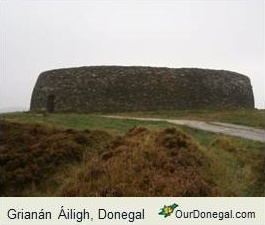
A Royal Dynasty and a Runaway Slave who Changed the World
It was during Niall Mór's reign that possibly the most significant event ever in Gaelic Celtic history occurred. An event, however, that seemed unremarkable at the time. A teenage boy was snatched during a foreign raid and sold into slavery on the Irish pagan Celtic market.
Having made his escape, some years later that noble youth voluntarily returned to the land of his former enslavement. By then, Laeghaire MacNiall had succeeded his father, Niall Mór, to the High Throne of Ireland, and King Laeghaire's aforementioned brothers, Conall and Eoghain, were kings in Donegal.
In grave danger to his life, that former runaway slave changed the course of Irish and world history forever. You might know his name?
He had a profound influence on Donegal, and is even connected with the Donegal Coat of Arms and Donegal Crest.
Donall MacLoghlin and Muircearth MacLoghlin
High King Niall Mór was also an ancestor of two later High Kings of Ireland from County Donegal, the MacLoghlin High Kings Donall and Muircearth.
Donall MacLoghlin, the hundred and
seventy ninth Gaelic monarch, also prince of Áileach in County Donegal was of Heremonian ancestry, being descended from Eoghain the son of Niall
Mór. He was High King of Ireland for thirty
five years, ruling jointly with Muirceartach O'Brian of Munster for
twenty one of those. Donall's father Ardgal,
king of Aileach, was the first in the family to assume the MacLoghlin
surname. 'Mac' is Gaelic for 'Son of', and Lochlonn translates to
'Strong at Sea', which was Ardgal's own father's name.
Muircearth
MacLoghlin, High King Donall's grandson and king of Áileach, was the
hundred and eighty second Gaelic High King of Ireland. His reign lasted
for ten years.
The Ancient Celtic Tribes of Gaelic Ireland
By the time the Milesians had established in Ireland, it seems the fearsome non-Celtic Fomorian pirates of the Atlantic had long been overpowered and driven back out to sea by the Tuatha de Danann.
The ancient Celtic tribes of Gaelic Ireland in all probability included small pockets of the surviving Firbolg and Tuatha de Danann.
In fact
some descendants of the Firbolg are believed to still exist
today in certain parts of County Donegal, and along pockets of Connaught
and County Kerry.
Island of Destiny
According
to an ancient Gaelic prophecy, Ireland is the destined home of the
Gaels until the end of time. Among other names, the Milesians called
Ireland Inis Fáil, Gaelic for 'Island of Destiny'.
You Might Also Like
Roll of the Gaelic Monarchs of Ireland (opens new window)
A list of the Gaelic Celtic High Kings of Ireland


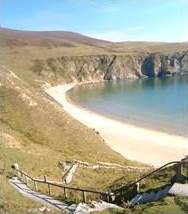

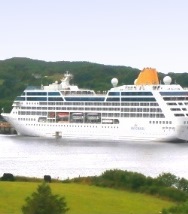
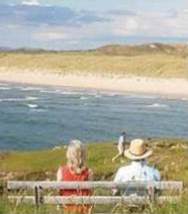

New! Facebook Comments